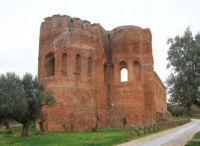|
|
 |
I PARCHI LETTERARIŪ IN CALABRIA “JOURNEYS TO THE FUTURE
OF MEMORY” - I PARCHI LETTERARI ON THE ISTHMUS: SCOLACIUM
In the City of Borgia (CZ), the Park preserves the
remains of the Greek city of Skylletion and the Roman
city of Scolacium. Skylletion was probably
established by Crotone, as an outpost in its strategy of
expansion against Locri. On the site of the Greek city,
which fell around the 2nd Century B.C., the Romans
founded the colony of Minervia Scolacium. Between 96 and
98 A.D., the Emperor Nerva promoted its re-colonisation.
The city took on the name of Minervia Nervia Augusta
Scolacium and became an important centre for trade with
the Orient. In the Byzantine age it was home to
Cassiodorus.
 Basilica
of Santa Maria Della Roccella Basilica
of Santa Maria Della Roccella
The term Roccelletta, which indicates the location,
appears for the first time in documents from 1096-1110,
which mention a monastery called Beatae Mariae de
Rokella, which was perhaps originally a Basilian complex.
It is one of the most important Medieval monuments of
Calabria. The building, with its Norman-inspired lines,
was constructed in several phases beginning in the first
part of the 12th Century.
The basilica boasts a unique nave of remarkable
dimensions (73 X 25 m), illuminated by five round arched
single holes and ends in a transept with three apses.
The presbytery, under which the crypt is positioned, is
accessed through and large archway with two narrow
lateral passageways. The roof was made of wooden trusses.
The decorative elements, no longer visible, had
Byzantine and Islamic influences.
|



